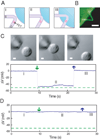Three-dimensional, flexible nanoscale field-effect transistors as localized bioprobes
- PMID: 20705858
- PMCID: PMC3149824
- DOI: 10.1126/science.1192033
Three-dimensional, flexible nanoscale field-effect transistors as localized bioprobes
Abstract
Nanoelectronic devices offer substantial potential for interrogating biological systems, although nearly all work has focused on planar device designs. We have overcome this limitation through synthetic integration of a nanoscale field-effect transistor (nanoFET) device at the tip of an acute-angle kinked silicon nanowire, where nanoscale connections are made by the arms of the kinked nanostructure, and remote multilayer interconnects allow three-dimensional (3D) probe presentation. The acute-angle probe geometry was designed and synthesized by controlling cis versus trans crystal conformations between adjacent kinks, and the nanoFET was localized through modulation doping. 3D nanoFET probes exhibited conductance and sensitivity in aqueous solution, independent of large mechanical deflections, and demonstrated high pH sensitivity. Additionally, 3D nanoprobes modified with phospholipid bilayers can enter single cells to allow robust recording of intracellular potentials.
Figures




Comment in
-
Reading cells from within.Nat Methods. 2010 Oct;7(10):780-1. doi: 10.1038/nmeth1010-780a. Nat Methods. 2010. PMID: 20936771 No abstract available.
References
-
- Eschermann JF, Stockmann R, Hueske M, Vu XT, Ingebrandt S, Offenhausser A. Action potentials of HL-1 cells recorded with silicon nanowire transistors. Appl. Phys. Lett. 2009;95:083703.
-
- Heller I, Smaal WTT, Lemay SG, Dekker C. Probing macrophage activity with carbon-nanotube sensors. Small. 2009;5:2528–2532. - PubMed
Publication types
MeSH terms
Substances
Grants and funding
LinkOut - more resources
Full Text Sources
Other Literature Sources

